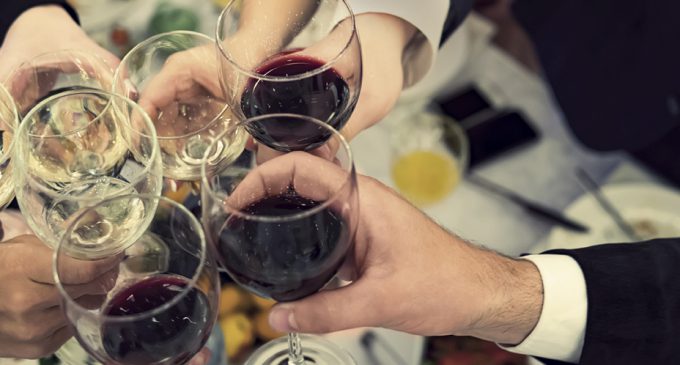CONGRATULATIONS AND CHEERS!

CONGRATULATIONS AND CHEERS!
Five tips to conquer the wine list at your next business function
By Chris McQueen
 Congratulations! You’ve finally land-ed your first big account after spending years chasing every plausible lead imaginable. And, of course, you know what that means. With all the fanfare comes the fancy celebration at a high-priced restaurant where you’re expected to pick up the check!
Congratulations! You’ve finally land-ed your first big account after spending years chasing every plausible lead imaginable. And, of course, you know what that means. With all the fanfare comes the fancy celebration at a high-priced restaurant where you’re expected to pick up the check!
But that’s not even the real challenge. Everything’s great. Everyone is smiling. And then the server hands you the wine list. Time to consider the delicate balance between impressing the new client and not blowing the company’s quarterly expense budget in one night.
Panic can sometimes ensue at this moment; however, that does not have to be the case. There are options. In fact, here are five tips for impressing the entire table with the perfect wine selection that also meets your budget:
Just because you can purchase a bottle of wine for $20 at the local market doesn’t mean it’s going to cost the same price at your favorite restaurant.
- Do your homework. Every few years, the growing seasons at the world’s most popular wine regions (Napa Valley, Bordeaux, Tuscany) combine the ideal conditions—the proper amount of sun, heat, rain and humidity—for producing the finest of fine wines. In essence, this means making the mediocre wines good and the good ones truly great. But here’s the neat part. The secret to learning about the best of the best is only a few mouse clicks away. A quick Google search of the top vintages compared to the restaurant’s wine list can produce a very valuable and rather impressive cheat sheet. And it doesn’t end there. Don’t forget to impress your colleagues by verifying the year of the selected vintage before the pour of a single glass. This will certainly set the mood in your favor.
- Don’t be afraid to skip the Cab. Many gourmet cuts of steak command the company of a dark-colored, full-bodied red wine like Cabernet Sauvignon (Cab). But while a Cab can often complement a fine filet mignon or T-bone dining experience, it can also be a costly choice that’s not enjoyed by novice wine drinkers. So, always be mindful of the tastes of your associates. Most wineries with great Cabs also often produce a pleasing, but yet less expensive variety of Zinfandels, Petite Syrahs or Merlots. Astutely survey the crowd and pick wisely. There’s no need to go overboard when a rich and full-bodied alternative will please just about everyone.
- Your server can also double as your resident expert. While not all restaurants have a Sommelier on staff, there will generally be a server who knows the wine list rather well. Don’t be afraid to ask for suggestions from the resident wine expert. Discreetly mentioning your budget will also help lead to recommendations that might not have otherwise been considered. Plus, most servers will be happy to share their knowledge given that their report card is norm-ally tendered in the form of a tip.
- Watch that markup. Just because you can purchase a bottle of wine for $20 at the local market doesn’t mean it’s going to cost the same price at your favorite restaurant. Most, if not all, restaurants mark up the wholesale value of the products they purchase. The question to consider is “How much?” Again, some additional homework may be required. Most restaurants post wine lists on their website. This is a wonderful place to research the alternatives before the night’s festivities. Pick some wines. Google their prices. And then be prepared to make the ideal choice after reviewing the menu pricing. This includes realizing that the typical markup for a bottle of wine should be no more than 2.5 to three times the standard retail cost. Any more could be considered excessive.
- What about the white? Depending on the party size, there is nothing wrong with asking the table if they’d prefer red or white. And then, making the extra effort to find out if your associates and guests would prefer to “butter or not butter.” Chardonnay, with its “buttery” taste is by far the most popular of the white wines and generally cheaper than the reds; but be careful. “Buttery” white wines are often either loved or hated. There’s seldom an in-between. Simply put, the buttery taste is produced by the juice fermenting for a considerable amount of time in an oak barrel before being bottled. This is in contrast to other Chardonnays that are stored in steel vats to produce a fruitier flavor. So, don’t be afraid to ask.
There you have it. So, impress your boss, clients, and colleagues during your next celebratory fine dining experience. Take your time. Do some research. Choose wisely. And most important, enjoy your big night out. Cheers! n
The author
Chris McQueen, CPCU, ARM, CIC, is senior vice president at Berkley Construction Professional, a Berkley Company. He has more than two decades of insurance experience specializing in the construction and design professional liability industry. A true oenophile, Chris is a connoisseur of wine, meaning he doesn’t just like it—he loves it and knows a lot about it. He is active in the CPCU Society and has been awarded the Outstanding Course Leader distinction as an Institute Instructor. Contact Chris at cmcqueen@berkleycp.com.











